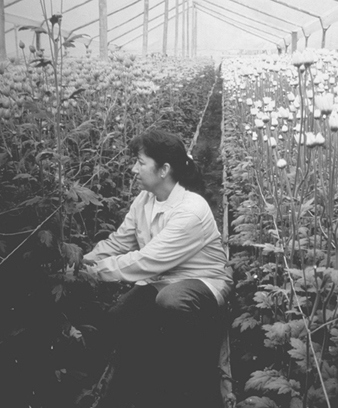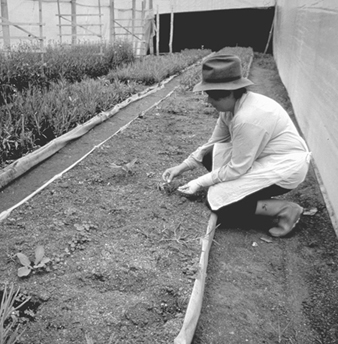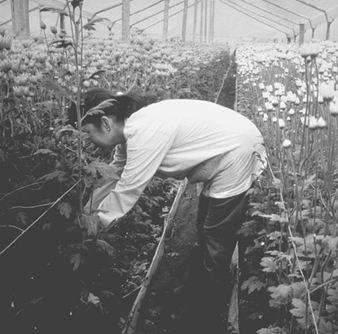Since the early 1990s, in many countries and across several continents, floriculture as an economic activity has been expanding rapidly. Its growing importance in export markets has resulted in an integrated development of several aspects of this field of activity, including production, technology, scientific research, transportation and conservation.
Production
The production of cut flowers has two essential components:
- the process of production, which involves all activities directly related to the generation and the development of the product up to the moment of packing
- the various activities that aid in the production and promote the marketing and distribution of cut flowers.
The production process itself can be divided into three basic parts: germination, cultivation and post-harvest procedures.
Germination is carried out by planting parent plants from which cuttings are obtained for cultivation.
The cuttings of different flowers are planted on beds of a rooting medium. The beds are made from steam-treated dross and treated with chemical products to disinfect the growing medium and to facilitate root development.
Cultivation is done in greenhouses which house the beds of rooting medium where the flowers are planted and grown as discussed in the article “Greenhouse and nursery operations” in this chapter and as shown in figure 1. Cultivation includes preparing the soil, planting the cuttings (figure 2) and harvesting the flowers.
Figure 1. Tending flowers in a greenhouse
Figure 2. Planting cuttings in a greenhouse
Planting includes the cycle that begins with placing the cuttings in the rooting medium and ends with the flowering plant. It includes the following activities: planting, normal irrigation, drip irrigation with fertilizer, cultivation and weeding of the soil, pinching the tip of the plants to force branching and obtain more flowers, preparing the props that hold the plants upright, and the growth, branching and flowering of the plant.
Production concludes with the gathering of the flowers and their separation by classification.
At the post-harvest stage—in addition to selection and classification—the flowers are covered with plastic hoods, a sanitary treatment is applied, and they are packed for shipment.
Secondary activities include monitoring the health of the plants to detect pests and to diagnose plant illnesses early, obtaining raw materials from the warehouse, and maintaining the furnaces.
Health Risk Factors
The most important risk factors in each of the different areas of work are:
- chemical substances
- extreme temperatures—heat
- non-ionizing radiation
- infectious disease
- ergonomic factors
- mechanical factors
- psychosocial factors.
Chemical substances
Intoxication and chronic illness due to pesticides
The levels of morbidity/mortality found in workers due to exposure to pesticides are not the consequence of a simple relation between the chemical agent and the person who has suffered exposure to it, but also reflect the interplay of many other factors. Among these are the length of exposure, individual susceptibility, the nutritional state of the person exposed, educational and cultural variables and the socioeconomic conditions under which the workers live.
In addition to the active ingredients of pesticides, the substances that convey the active ingredients and the additives should also be taken into consideration, because sometimes those substances can have adverse effects that are more harmful than those of the active ingredients.
The toxicity of pesticides made with organophosphates is due to their effect on the central nervous system, because they inhibit the activity of the enzyme acetylcholinesterase. The effects are cumulative, and delayed effects have also been noted on the central and the peripheral nervous systems. According to studies carried out in several countries, the prevalence of inhibition of this enzyme among workers who handle these pesticides fluctuates between 3 and 18%.
The long-term effects are pathological processes that develop after a latency period and are due to repeated exposures. Among the long-term effects known to be due to pesticide exposure are skin lesions, nerve damage and mutagenic effects.
Respiratory problems
Decorative plants can irritate the respiratory system and cause coughing and sneezing. In addition, plant scents or odours may exacerbate symptoms of asthma or allergic rhinitis, although they have not been shown to cause allergies. Pollen from the chrysanthemum and the sunflower can cause asthma. Dust from dried plants sometimes causes allergies.
Dermatitis
The cases of occupational dermatitis found in floriculture are about 90% primarily due to contact dermatitis. Of these, about 60% are caused by primary irritants and 40% are due to allergic reactions. The acute form is characterized by reddening (erythema), swelling (oedema), pimples (papules), vesicles or blisters. It is especially localized on the hands, wrists and forearms. The chronic form can have deep fissures, lichenification (thickening and hardening) of the skin, and severe xerosis (dryness). It can be incapacitating and even irreversible.
Floriculture is one of those activities where contact with primary irritants or allergenic substances is high, and for that reason it is important to promote and use preventive measures, such as gloves.
Extreme temperatures—heat
When work must be carried out in a hot environment, as in the case of hothouses, the thermal load on the worker is the sum of the heat of the work environment plus the energy expended on the task itself.
Physical effects of excessive exposure to heat include heat rash, cramps and muscle spasms, exhaustion and fainting spells. Heat rash, in addition to being uncomfortable, lowers the worker’s tolerance to heat. If perspiration is abundant and liquids and electrolytes are not replenished adequately, cramps and muscle spasms can set in. Heat exhaustion occurs when vasomotor control and cardiac output are insufficient to compensate for the additional demands placed on these systems by the heat stress. Fainting spells represent a very serious clinical situation that can lead to confusion, delirium and coma.
Precautions include frequent rest breaks in cool areas, availability of beverages to drink, rotating of tasks requiring heavy exertion and wearing of light-coloured clothing.
Non-ionizing radiation
The most important kinds of non-ionizing radiation that floriculture workers are exposed to are ultraviolet (UV) radiation, visible light and infrared radiation. The most serious effects of UV radiation are solar erythema, actinic dermatitis, irritative conjunctivitis and photokeratitis.
Radiation from the visible spectrum of light may cause retinal and macular degeneration. One symptom of exposure to infrared radiation is superficial burn of the cornea, and prolonged exposure can lead to the premature appearance of cataracts.
Precautions include keeping the skin covered, wearing tinted glasses, and medical surveillance.
Ergonomic factors
Workers who maintain a static body posture for long periods of time (see figure 3) can suffer from resulting static muscle contractions and from alterations of the peripheral, vascular and nervous systems. Repetitive movements are more common in tasks that require manual dexterity. For example, clipping shears can require a lot of force and involve repetitive motion. The most frequently observed effects are musculoskeletal impairments, including tendinitis of the elbow and wrist, carpal tunnel syndrome and impairment of movement at the shoulder.
Figure 3. Bending over for extended periods is a common cause of ergonomic problems
Job rotation and the proper ergonomic design of equipment such as clipping shears are needed precautions. Redesigning the workplace to require less bending is another solution.
Infectious diseases
Floriculture may expose workers to a variety of biological agents. Early signs of an infection are rarely specific, although they are generally well-defined enough to lead to a suspicion of illness. The signs, symptomatology and precautions depend on the agent, which includes tetanus, rabies, hepatitis and so on. Preventive measures include a source of potable water, good sanitary facilities, first aid and medical care for cuts and abrasions.
Other factors
The most common health and safety hazards associated with mechanical factors are cuts, abrasions and single and multiple traumas, which most frequently injure the hands and face. Such injuries must be attended to immediately. Workers should have up-to-date tetanus shots and adequate first-aid facilities must be available.
The psychosocial environment can also endanger worker health. The results of exposure to these factors can have the following consequences: physiological changes (indigestion, constipation, palpitations, difficulty breathing, hyperventilation, insomnia and anxiety); psychological disturbances (tension and depression); and behavioural disturbances (absenteeism, instability, dissatisfaction).



